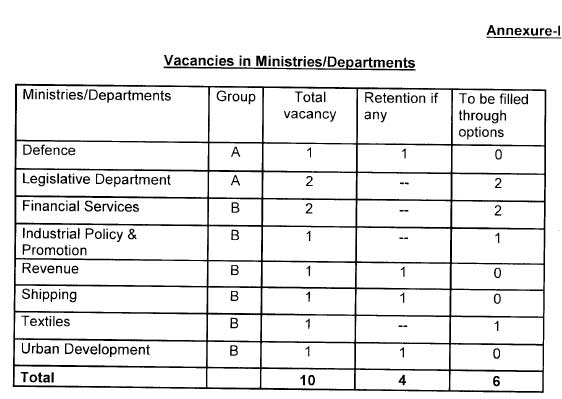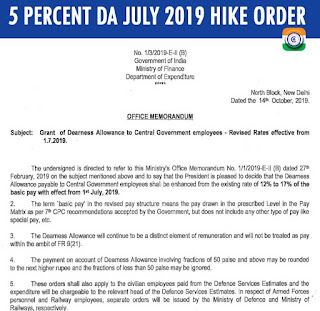AICPIN March 2016 – Expected DA July 2016 – 3rd Stage Completed

Press Release of AICPIN for the month of march 2016
The All-India CPI-IW for March, 2016 increased by 1 point and pegged at 268 (two hundred and sixty eight). On 1-month percentage change, it increased by (+) 0.37 per cent between February, 2016 and March, 2016 when compared with the increase of (+) 0.40 per cent between the same two months a year ago.
The maximum upward pressure to the change in current index came From Food group contributing, (+) 0.37 percentage points to the total change. At item level. Wheat and Wheat Atta, Fish Fresh, Goat Meat, Poultry (Chicken), Milk, Chillies Dry. Chillies Green, Potato, Seasonal Green Vegetables and Fruit items, Tea (Readymade). Sugar, Private Tuition Fee, etc. are responsible for the increase in index. However, this increase was checked by Rice, Arhar Dal. Mustard Oil, Eggs (Hen), Garlic. Onion. Tomato, Supari. Petrol, Flower/Flower Garlands, etc.. putting downward pressure on the index.
The year-on-year inflation measured by monthly CPI-IW stood at 5.51 per cent for March, 2016 as compared to 5.53 per cent for the previous month and 6.28 per cent during the corresponding month of the previous year. Similarly, the Food inflation stood at 6.16 per cent against 6.18 per cent of the previous month and 6.98 per cent during the corresponding month of the previous year.
At centre level, Munger-Jamalpur reported the maximum increase of 10 points followed by Raniganj (9 points) and Ludhiana (7 points). Among others, 5 points increase was observed in 4 centres, 3 points in another 9 centres, 2 points in 9 centres and I point in 14 centres. On the contrary, Mundakkayam recorded a maximum decrease of 6 points followed by Ernakulam and Puducherry (5 points each). Tiruchirapally and Warrangal (4 points each). Among others, 3 points decrease was observed in 2 centres, 2 points in 9 centres and 1 point in another 9 centres. Rest of the 14 centres’ indices remained stationary.
The indices of 33 centres are above All-India Index and other 43 centres indices are below national average. The indices of Bokaro and Varanasi centres remained at par with All-India Index.
The next issue of CPI-IW for the month of April, 2016 will be released on Tuesday, 31st May, 2016.
The same will also be available on the office website www.labourbureaunew.gov. in.
Authority: www.labourbureaunew.gov. in
Press Release of AICPIN for the month of march 2016
No. 5/1/2016- CPI
GOVERNMENT OF INDIA
MINISTRY OF LABOUR & EMPLOYMENT
LABOUR BUREAU
GOVERNMENT OF INDIA
MINISTRY OF LABOUR & EMPLOYMENT
LABOUR BUREAU
`CLEREMONT’, SHIMLA-171004
DATED: 29th April, 2016
DATED: 29th April, 2016
Press Release
Consumer Price Index for Industrial Workers (CPI-IW) – March, 2016The All-India CPI-IW for March, 2016 increased by 1 point and pegged at 268 (two hundred and sixty eight). On 1-month percentage change, it increased by (+) 0.37 per cent between February, 2016 and March, 2016 when compared with the increase of (+) 0.40 per cent between the same two months a year ago.
The maximum upward pressure to the change in current index came From Food group contributing, (+) 0.37 percentage points to the total change. At item level. Wheat and Wheat Atta, Fish Fresh, Goat Meat, Poultry (Chicken), Milk, Chillies Dry. Chillies Green, Potato, Seasonal Green Vegetables and Fruit items, Tea (Readymade). Sugar, Private Tuition Fee, etc. are responsible for the increase in index. However, this increase was checked by Rice, Arhar Dal. Mustard Oil, Eggs (Hen), Garlic. Onion. Tomato, Supari. Petrol, Flower/Flower Garlands, etc.. putting downward pressure on the index.
The year-on-year inflation measured by monthly CPI-IW stood at 5.51 per cent for March, 2016 as compared to 5.53 per cent for the previous month and 6.28 per cent during the corresponding month of the previous year. Similarly, the Food inflation stood at 6.16 per cent against 6.18 per cent of the previous month and 6.98 per cent during the corresponding month of the previous year.
At centre level, Munger-Jamalpur reported the maximum increase of 10 points followed by Raniganj (9 points) and Ludhiana (7 points). Among others, 5 points increase was observed in 4 centres, 3 points in another 9 centres, 2 points in 9 centres and I point in 14 centres. On the contrary, Mundakkayam recorded a maximum decrease of 6 points followed by Ernakulam and Puducherry (5 points each). Tiruchirapally and Warrangal (4 points each). Among others, 3 points decrease was observed in 2 centres, 2 points in 9 centres and 1 point in another 9 centres. Rest of the 14 centres’ indices remained stationary.
The indices of 33 centres are above All-India Index and other 43 centres indices are below national average. The indices of Bokaro and Varanasi centres remained at par with All-India Index.
The next issue of CPI-IW for the month of April, 2016 will be released on Tuesday, 31st May, 2016.
The same will also be available on the office website www.labourbureaunew.gov. in.
Authority: www.labourbureaunew.gov. in













